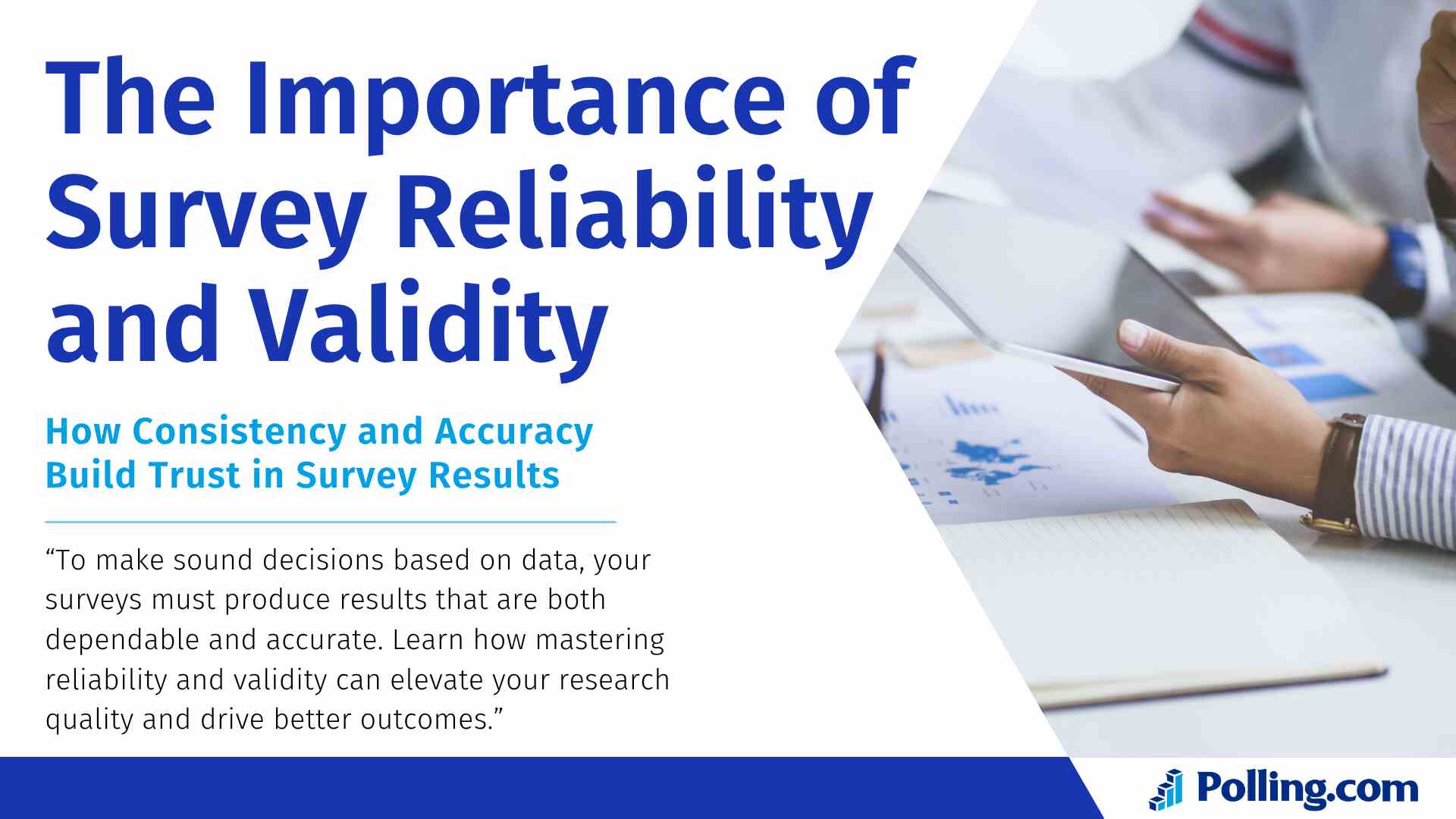
Why Survey Reliability and Validity Should Be Your Top Priorities
Survey reliability is one of the most essential factors in producing trustworthy and actionable insights from any research survey. Without reliable data, your conclusions can be misleading, your decisions may falter, and your strategies might fail. So how can you ensure your surveys are dependable? That’s where understanding survey reliability and validity becomes vital.
Polling.com, a trusted platform in survey research, emphasizes the importance of both reliability and validity in its methodology and tools. This article will explore why these two concepts should be your top priorities, how they work together, and how you can apply best practices to improve them in your own surveys.
What Is Survey Reliability?
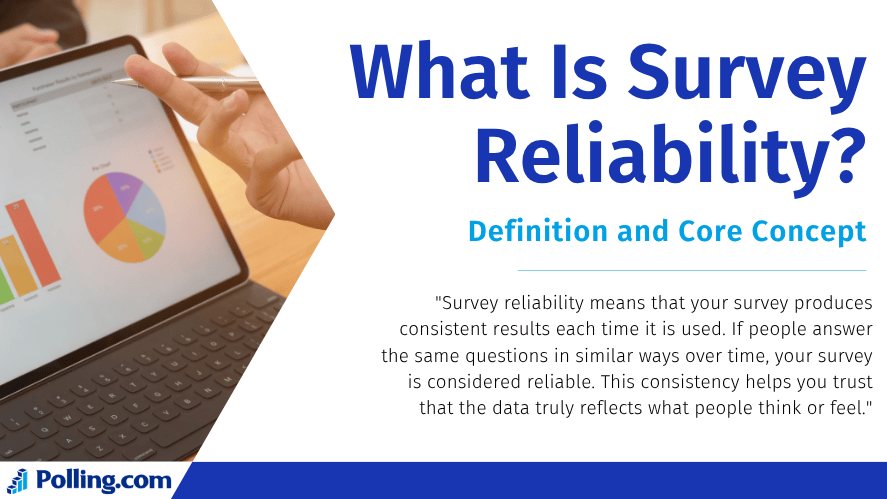
Survey reliability refers to the consistency of a survey’s results over time. If you give the same survey to similar groups under similar conditions and get the same outcomes, your survey is considered reliable. In other words, a reliable survey yields stable and repeatable data.
This is important because consistency is the foundation of any trustworthy research method. If your survey gives you wildly different results each time it is administered, then it becomes impossible to draw solid conclusions or make informed decisions.
Types of Survey Reliability
Understanding the different forms of survey reliability helps you apply the right strategies depending on your survey type and goals.
1. Test-Retest Reliability
This type measures the stability of results over time. You administer the same survey to the same group at two different times and compare the results. High correlation indicates good test-retest reliability.
2. Inter-Rater Reliability
Inter-rater reliability evaluates the degree of agreement between different people rating or observing the same thing. For instance, if two researchers score a participant’s open-ended answers similarly, the survey has high inter-rater reliability.
3. Internal Consistency
This type checks how well the items within a survey measure the same construct. Tools like Cronbach’s alpha help determine whether your questions are consistently related. If your questions are too varied, the internal consistency drops.
Why Survey Reliability Is Critical
Reliable results help businesses, researchers, and policy makers make decisions with confidence. Inaccurate or unstable data leads to poor planning and failed strategies.
For example, Polling.com uses automated checks and repeated field tests to ensure their surveys produce repeatable results. Whether you’re running a market research survey or conducting academic survey research, reliability ensures your efforts are not wasted.
Without survey reliability, even the best-designed questions can lead to flawed interpretations.
What Is Survey Validity?
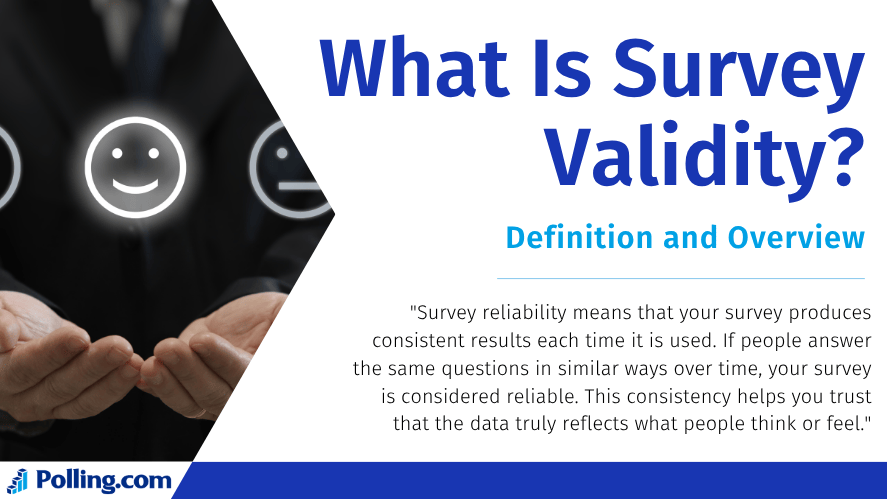
Survey validity is about ensuring that the questions accurately capture the topic or concept they are intended to assess. A survey can be reliable (consistent) but still invalid (not measuring the intended topic). Validity ensures that your data is meaningful and relevant to your research goals.
If you want to assess customer satisfaction but end up measuring general brand awareness, your survey might be consistent but not valid.
Types of Survey Validity
To fully understand survey validation, let’s explore the major types:
1. Content Validity
This evaluates whether your survey addresses all the key areas related to the topic being studied. If you’re studying customer service satisfaction, your questions should touch on speed, politeness, problem-solving, and follow-up.
2. Construct Validity
Construct validity looks at how well your survey represents the underlying idea or theory it’s meant to reflect. This often involves comparing it with existing research or theoretical frameworks.
3. Criterion Validity
Criterion validity compares your survey results with a known outcome or benchmark. For instance, if responses on a job performance questionnaire closely match real-world job outcomes, it shows strong criterion validity.
Key Differences from Reliability
Let’s clarify the difference between survey validity and reliability using a simple comparison.
| Feature | Reliability | Validity |
|---|---|---|
| Meaning | Consistency of results | Accuracy of what is measured |
| Can exist without the other? | Yes | No, not useful if not reliable |
| Measurement method | Statistical correlation | Logical alignment with research goals |
| Example | Same score every time | Right questions for the right topic |
Both are necessary for a validating surveys process that leads to sound decisions.
Survey Reliability vs. Validity: Why Both Matter
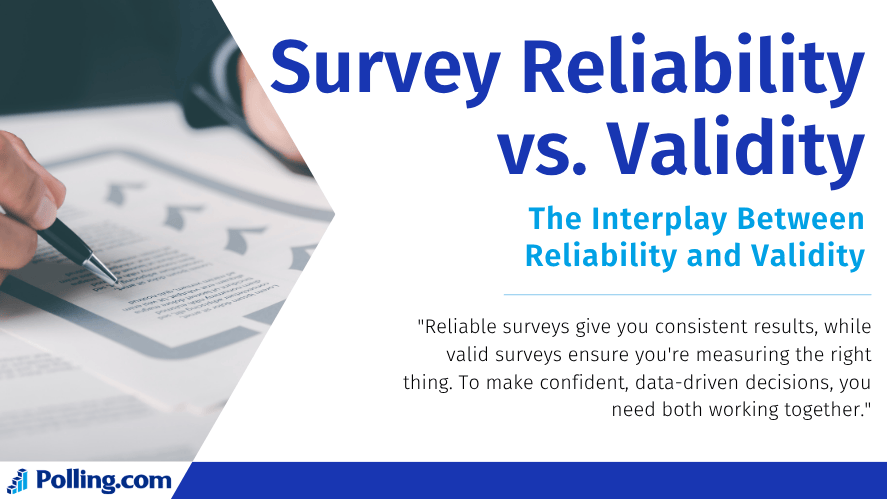
A survey can be reliable without being valid, but the reverse is rarely true. For example, imagine asking the same three questions about shoe preference across several groups and always getting similar responses. This shows reliability. But if your actual goal was to understand overall fashion taste, then the survey lacks validity.
In short, survey reliability and validity must work hand in hand. Reliable data builds confidence, while valid data ensures the relevance of insights.
How Ignoring One Undermines the Other
Let’s consider the consequences of neglecting either one:
- A reliable survey with poor validity might lead you to draw the wrong conclusions even though your data looks consistent.
- A valid survey with poor reliability can give unpredictable results, making your findings unstable.
- Low survey response rate validity can distort both reliability and validity, especially in market research surveys where participation rates influence results heavily.
In both cases, ignoring one element sabotages your whole research effort.
How to Improve Survey Reliability
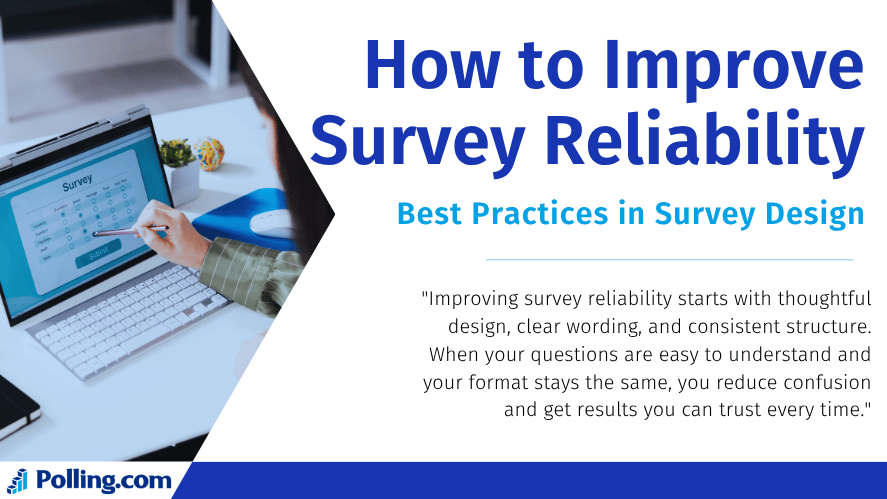
To enhance reliability, start with careful design. Here are some practices:
- Use clear question wording. Avoid jargon and double-barreled questions.
- Include standardized response formats such as Likert scales.
- Pilot test the survey before launching.
- Randomize random survey questions where appropriate to reduce bias.
All of these techniques help reduce variance caused by misunderstanding or misinterpretation.
Using the Right Tools
Polling.com’s platform is built to enhance reliable surveying from the ground up. Their templates and logic checks help ensure surveys produce consistent results. For example:
- Automated skip logic prevents respondents from seeing irrelevant questions.
- A/B testing identifies which formats deliver consistent feedback.
- Standard templates improve survey data collection quality.
Compared to tools like SurveyMonkey or Typeform, Polling.com stands out with deeper integration of reliability metrics during survey design.
How to Ensure Survey Validity
Alignment with Objectives
One of the first steps in ensuring survey validity is aligning your questions with clear research goals. Before writing any question, ask yourself:
- What decision will this data help me make?
- Is this question directly tied to my research objective?
When your survey has a focused goal, each question adds value, which improves survey validation.
Pretesting and Pilot Studies
To truly validate survey content, always pretest your questions.
- Conduct cognitive interviews to understand how participants understand and process each question.
- Review the pilot survey results to identify unclear questions or patterns of inconsistent responses.
If you’re wondering how do you validate a survey, this is where the process begins. It doesn’t stop until you have strong content and construct validity confirmed through small tests before going live.
Polling.com also helps you validate survey elements during design through guided workflows and pre-launch testing tools.
Common Pitfalls and How to Avoid Them
When designing surveys, certain mistakes can hurt both reliability and validity.
Leading Questions
Avoid questions that suggest a particular answer. For example:
- Poor: “How great was your experience with our support team?”
- Better: “How would you rate your experience with our support team?”
Ambiguous Terminology
Use clear and direct language. Words like “often” or “rarely” mean different things to different people. Always define such terms or use scales instead.
Biased Sampling
If your sample does not reflect your target audience, your data won’t be valid. This is especially risky in market research survey scenarios.
Inadequate Pre-Testing
Skipping pilot tests leads to poor question phrasing and structural issues. This reduces both reliability and validity in the final results.
Final Thoughts: Building Trust Through Reliable and Valid Surveys
Creating trustworthy surveys is more than just collecting responses. It’s about building a system that ensures each piece of data is consistent, accurate, and useful.
Here’s what you should take away:
- Survey reliability ensures consistency across time and formats.
- Survey validity ensures your questions are measuring what they should.
- You need both to produce effective research survey tools.
- Using modern platforms like Polling.com gives you built-in tools to support both.
- Always validate your survey design with pilot testing, clear questions, and unbiased samples.
If you’re looking to create high-quality market research surveys, invest the time in validating surveys the right way. Explore Polling.com’s tools to create better, more actionable surveys that lead to smart decisions and real insights.
